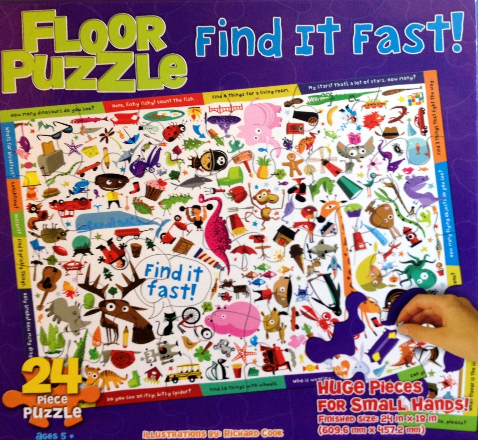Work on figure ground, visual discrimination, spatial relations, eye-hand coordination, visual memory, manual dexterity, play and leisure exploration and participation
In the box: 24 large pieces
Ages 5+
Very similar to I SPY games and books, but in a puzzle form with large pieces (see image above). Once the puzzle is assembled, then the real fun begins. Follow the directions around the border of the puzzle to search and find things. So you won't have to squint and try to make them out from the image above, I will list them here:
- How many dinosaurs do you see?
- Here fishy, fishy! Count the fish.
- Find four things for a living room.
- My stars! That's a lot of stars. How many?
- Find three things that light the way.
- How many flying objects do you see?
- What flavor is the ice cream cone?
- Can you find the cheese, please?
- Who is wearing a bow tie?
- Find 10 things with wheels.
- Do you see an itsy, bitsy spider?
- Find 4 noisy things.
- Holy smoke! How many dragons do you see?
- Find 3 prickly things.
- What's for breakfast?
- Dessert?
- Lunchtime?
- Take the opportunity for conversation if the individual gives an unconventional answer. Would you eat candy for breakfast? Does that mouse have wheels? A monkey in the living room?! Maybe, if it's a pet.
- Use the fact that the picture has no rhyme or reason to work on using the box as a guide. Find the piece on the box first, remember the location, look down and place the piece in the same location on the puzzle.
- Give the individual one piece that can be placed and choose one dominating feature from it, such as the pink dinosaur or the moose antlers. Ask him to find that object on the box first. Then ask him to remember the area, find that same location on the puzzle, and place the piece.
- Concentrate on identifying pieces with straight edges and corners. Since the border is made up of color blocks and words, use it to help individuals put the frame together first.
- Use consistent positional language, such as left, right, top, bottom, middle. Or practice north, south, east and west.




No comments:
Post a Comment
Thank you for taking the time to comment.